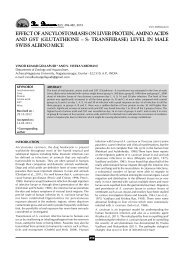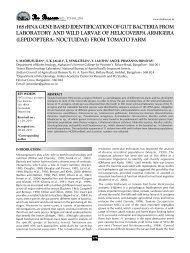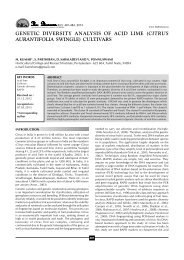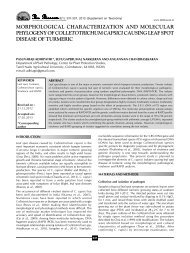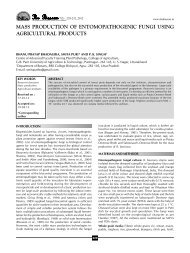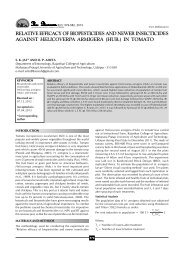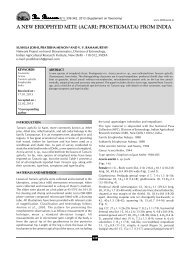Isolation and characterization of PGPR associated ... - THE BIOSCAN
Isolation and characterization of PGPR associated ... - THE BIOSCAN
Isolation and characterization of PGPR associated ... - THE BIOSCAN
You also want an ePaper? Increase the reach of your titles
YUMPU automatically turns print PDFs into web optimized ePapers that Google loves.
A. KUSHWAHA et al.,<br />
Table 1: Cultural characteristics <strong>of</strong> the Isolates<br />
Isolate Elevation Margin Colour Odour<br />
AK 1 Raised Smooth Yellowish Odourless<br />
AK 2 Raised Smooth Yolk yellowish Odourless<br />
AK 3 Raised Smooth Yellowish Odourless<br />
AK 4 Raised Smooth Yellowish Odourless<br />
Table 2: Morphological characteristics <strong>of</strong> the Isolates<br />
Isolate Shape Arrangement Gram reaction<br />
AK 1 Rod Staphylo -ve<br />
AK 2 Rod Strepto -ve<br />
AK 3 Rod Staphylo -ve<br />
AK 4 Rod Staphylo -ve<br />
(Table 4). The growth <strong>of</strong> all isolates was good in the temperature<br />
ranges <strong>of</strong> 28ºC to 40ºC. In addition, AK 3 <strong>and</strong> AK 4 isolates<br />
showed maximum growth at 40ºC.<br />
Pot experiment<br />
The highest root length (4 cm) was recorded in AK 4 among the<br />
four isolates. The <strong>PGPR</strong><br />
Isolates significantly affected the shoot length <strong>of</strong> cauliflower<br />
seedlings. Results reveal that shoot length increased in <strong>PGPR</strong><br />
treated plants over uninoculated control (Fig. 5). The highest<br />
shoot length (11.8cm) was recorded in AK 3 among the four<br />
isolates. The highest fresh weight (0.067gm) was recorded in<br />
AK 3 among the four isolates.<br />
A significant increase in dry matter <strong>of</strong> cauliflower seedlings<br />
was observed in response to <strong>PGPR</strong> isolates. The highest dry<br />
matter was recorded in isolate AK 3 (Table 5).<br />
Table 3: Biochemical characteristics <strong>of</strong> <strong>PGPR</strong> isolates<br />
Isolates AK1 AK2 AK3 AK4<br />
Methyl red test _ + _ +<br />
H S production test 2 + + + +<br />
Catalase test + + + +<br />
Casein hydrolysis test +++ _ + ++<br />
Gelatin hydrolysis test + + + +<br />
Indole tests + ++ +++ ++<br />
Phosphate sol.test _ + + +<br />
NH 3 test + + + +<br />
Identification Azospirillum PseudomonasAzotobacter<br />
Table 4: Growth under different temperature conditions<br />
Isolates Temperature<br />
4°C 12°C 28°C 40°C<br />
AK 1 _ _ ++ ++<br />
AK 2 _ _ ++ +<br />
AK 3 _ _ ++ +++<br />
AK 4 _ _ ++ +++<br />
Table 5: Effect <strong>of</strong> <strong>PGPR</strong> isolates on growth <strong>of</strong> cauliflower plant<br />
Isolate Root length Shoot Fresh Dry<br />
(cm) length weight weight<br />
(cm) (g) (g)<br />
Control 1.0 4.0 0.032 0.003<br />
AK 1 2.0 7.3 0.041 0.004<br />
AK 2 1.5 8.0 0.043 0.006<br />
AK 3 3.0 11.8 0.067 0.008<br />
AK 4 4.0 10.0 0.058 0.007<br />
98<br />
DISCUSSION<br />
The isolates AK 1 , AK 2 , AK 3 <strong>and</strong> AK 4 induced the IAA production.<br />
On contrary, AK 2 <strong>and</strong> AK 4 were found to be medium producer<br />
<strong>of</strong> IAA in comparison to the weak producer isolate AK 1 . It has<br />
been reported that IAA production by <strong>PGPR</strong> can vary among<br />
different species <strong>and</strong> it is also influenced by culture condition,<br />
growth stage <strong>and</strong> substrate ability (Mirza et al., 2001).<br />
Plant rhizosphere is known to be preferred ecological niche<br />
for soil microorganisms due to rich nutrient availability. Reports<br />
were available on Azotobacter spp. isolated from different<br />
sources showed IAA production (Gonzalez-Lopez et al., 2008;<br />
Jagnow, 1987; Nieto <strong>and</strong> Frankenberger, 1989). In the present<br />
study IAA production in Azotobacter isolates were in<br />
agreement with earlier reports. The ability <strong>of</strong> bacteria to<br />
produce IAA in the rhizosphere depends on the availability <strong>of</strong><br />
precursors <strong>and</strong> uptake <strong>of</strong> microbial IAA by plant. Growth<br />
promotion may be attributed to other mechanisms such as<br />
production <strong>of</strong> plant growth promoting hormones in the<br />
rhizosphere <strong>and</strong> other PGP activities (Arshad <strong>and</strong><br />
Frankenberger, 1993; Glick, 1995). Higher level <strong>of</strong> IAA<br />
production by Pseudomonas was recorded by other workers<br />
(Xie et al., 1996).<br />
Phosphorus is one <strong>of</strong> the major nutrients, second only to<br />
nitrogen in requirement for plants. Most <strong>of</strong> phosphorus in soil<br />
is present in the form <strong>of</strong> insoluble phosphates <strong>and</strong> cannot be<br />
utilized by the plants (Pradhan <strong>and</strong> Sukla, 2006). In<br />
comparison to non-rhizospheric soil, a considerably higher<br />
concentration <strong>of</strong> phosphate-solubilizing bacteria was<br />
commonly found in the rhizosphere (Raghu <strong>and</strong> MacRae,<br />
1966). The isolates AK 2 , AK 3 <strong>and</strong> AK 4 were able to solubilize<br />
phosphate in the rhizosphere soil.<br />
The <strong>PGPR</strong> isolates remarkably affected the germination <strong>of</strong><br />
cauliflower seeds. The highest seed germination was recorded<br />
when seeds were pretreated with AK 3 isolate. A large body <strong>of</strong><br />
evidence suggests that <strong>PGPR</strong> enhance the growth, seed<br />
emergence <strong>and</strong> crop yield (Dey et al., 2004; Kloepper et al.,<br />
2004; Kokalis-Burelle et al., 2006; Herman et al., 2008).<br />
REFERENCES<br />
Adesemoye, A. O. <strong>and</strong> Kloepper, J. W. 2009. Plant–microbes<br />
interactions in enhanced fertilizer-use efficiency. Applied Microbiology<br />
<strong>and</strong> Biotechnology 85: 1-12.<br />
Arshad, M. <strong>and</strong> Frankenberger, Jr. W. T. 1993. Microbial production<br />
<strong>of</strong> plant growth regulators. Marcel <strong>and</strong> Dekker, New York 307–347.<br />
Blezevic, D. J. <strong>and</strong> Ederer, G. M. 1975. Principles <strong>of</strong> biochemical<br />
tests in diagnostic microbiology, Wiley <strong>and</strong> Company, New York. 13-<br />
45.<br />
Cappuccino, J. G. <strong>and</strong> Sherman, N. 1992. Microbiology: A laboratory<br />
manual. The Benjamin/Comings Publishing Company, Inc., California.<br />
Dey, R., Pal, K. K., Bhatt, D. M. <strong>and</strong> Chauhan, S. M. 2004. Growth<br />
promotion <strong>and</strong> yield enhancement <strong>of</strong> peanut (Arachis hypogaea L.) by<br />
application <strong>of</strong> plant growth-promoting rhizobacteria. Microbiological<br />
Research 159: 371-394.<br />
Glick, B. R. 1995. The enhancement <strong>of</strong> plant growth by free living<br />
bacteria. Canadian J. Microbiology. 41: 109-114.<br />
Gonzalez-Lopez, J., Salmeron, V., Martinez-Toledo, M. V., Ballesteros,<br />
F. <strong>and</strong> Ramos-Herman, M. A. B., Nault, B. A. <strong>and</strong> Smart, C. D. 2008.<br />
Effects <strong>of</strong> plant growth promoting rhizobacteria on bell pepper



